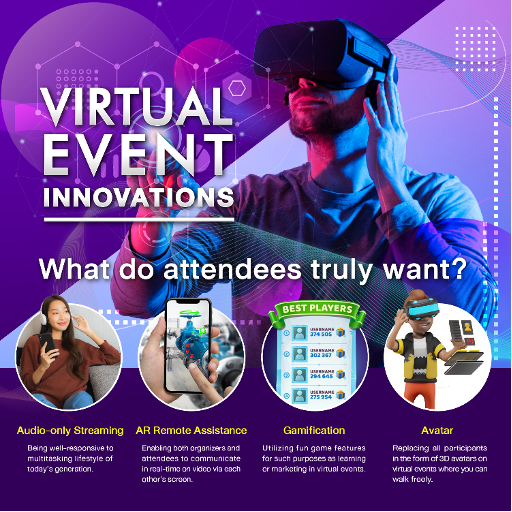Virtual Event Innovations; What do attendees truly want?

Virtual Events or online events are considered as the development of MICE events’ types that simulate physical event venues into an online world which can be attended worldwide with the internet access. Even though virtual events are popular among the organizers and attendees, organizing virtual events that is interesting enough is a big challenge as the attendees are now looking for an experience that specifically meets their desires. What do organizers have to do to make such deliverable and leave an impression on the attendees? Let's find out.
Audio-only Streaming
Since the organizers turn on-site seminars into online seminars via video calling platform, some participants experience the “Zoom Burnout” or the boredom from repeatedly attending on-screen meetings which negatively affect their exhausted eyes from staring at the screen for a long time. It also has occurred in times that popularity in audio content is growing rapidly such as podcasts from influencers, and ASMR: the relaxing performed sound of non-vocal ambient noises like ocean waves crashing on the shore, rain, wind, etc. Moreover, there is the audio-only films that get the listeners to imagine the crystal clear pictures without any screens. So, listening to Audio-only Streaming are well-responsive to multitasking lifestyle of today’s generation. When organizing the virtual events, the organizers should offer both visual and audio options for attendees to choose their preferences as they like and make sure that content can be recorded in podcasts for later consumption. Hence, the listeners would not miss any other contents and it is also widening the reach of various kinds of audiences later.
AR Remote Assistance
Organizing online workshops, where participants have to perform certain tasks, can be considered as troublesome as instructors can't fully provide hands-on instructions because of the long distance between participants and organizers. However, all mentioned problems can be solved with the technology, “AR Remote Assistance” or AR which has a function enabling both organizers and attendees to write and communicate in real-time on video via each other's screen. For example, AR Software like Vuforia Chalk is designed to aid communication between field technicians and office-based professionals when apparent detailed explanation of the operation is required. Also, electronic equipment companies begin to utilize this technology to explain the equipment installation process to customers. This technology can be adapted for workshops so that organizers or instructors can precisely provide detailed instructions and comments with no communication barriers. It also helps the organizers to be closer to attendees more than ever.
Gamification
Virtual Events need an engagement between the organizers and attendees so the events can be run smoothly and the technology that will create entertainment and interactions among participants is “Gamification”. It utilizes fun game features consisting of rules, points and prizes for such purposes as learning or marketing. In addition, virtual events can be adapted to various fun activities and some examples are hosting quiz sessions with prize offer to capture the participants' attention on the contents or giving point rewards when attendees complete their visit to a specified number of virtual booths, which can also promote business sponsors’ booths at the events. The organizers can also distribute gift cards or provide higher value reward for attendees to access premium content of the events. Gamification is a great tool which will make a remarkable impression on the attendees certainly.
Avatar
The current trend, “Metaverse” has created “Avatar” which simulates ourselves to live in virtual world on social medias. MICE industry perfectly employs Avatar to virtual events by replacing the participation of delegates in the form of 3D avatars. Even when you are not at the real events, you can attend and walk around virtual events by your 3D avatars. The organizers usually make use of Avatar in trade shows, exhibitions, conferences, and other events such as running marathons or concerts. Avatar will get the attendees to feel like being in the actual events and gain an exceptional experience unlike no others.
What we have presented you today probably amazes you with such innovations and technologies that can be used in virtual events including sounds, pictures, games, and 3D employed to virtual events. These innovations and technologies not only facilitate the organizers to be able to host the virtual events easier, but also entertain the participants to enjoy and receive an extraordinary experience no less than normal events.
